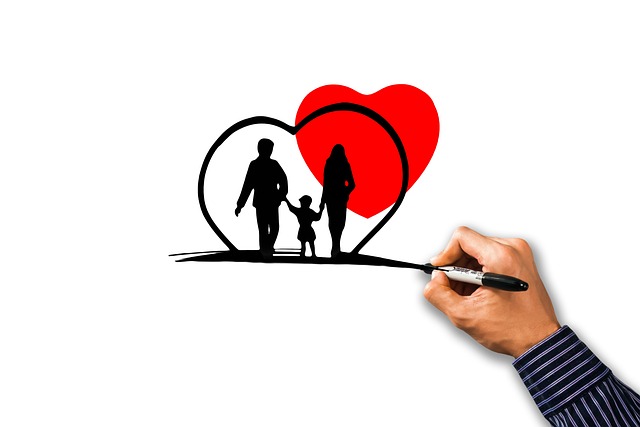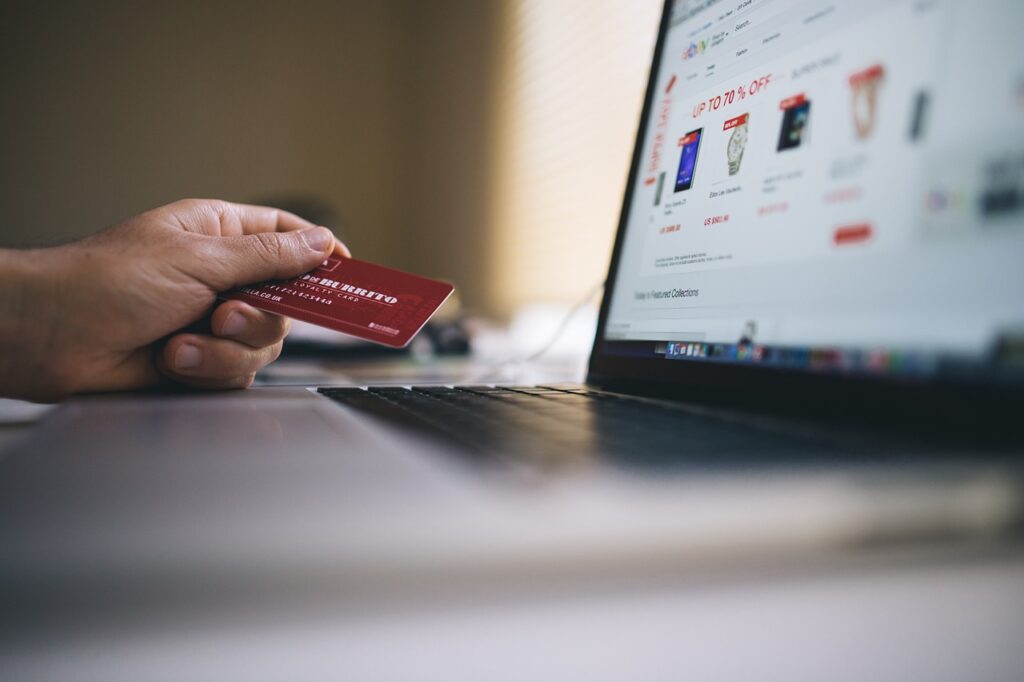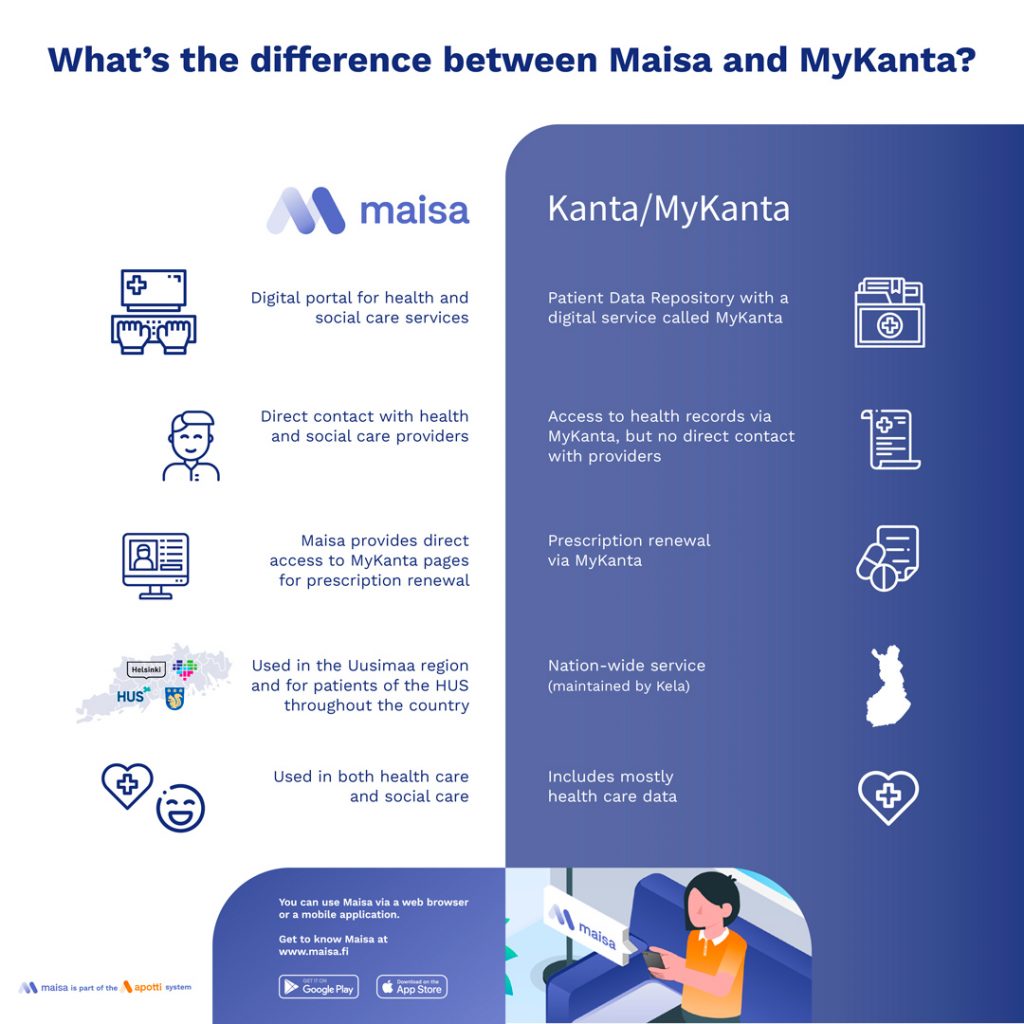The Social Insurance Institution of Finland
I currently have both a Finnish and a European healthcare card. The card is valid for two years. A new card will be automatically sent from Kela as the expiration date of the old card approaches. I pay the student health care fee to Kela, but I do not currently receive any benefits from Kela. Both of our children receive child benefits. My spouse takes care of our two-year-old child at home and receives a home care allowance from Kela. Previously, I have received a parental allowance as well as a home care allowance.
I logged into OmaKanta using my online banking credentials. Logging in is simple and can be done, for example, with the bank’s mobile application or mobile ID. You can access your own health information, prescriptions, or laboratory test results in OmaKanta. I believe that OmaKanta would be more accessible if there was already a mobile application available for it. Although the development of the application is underway, it’s unfortunate that the Ministry of Social Affairs and Health hasn’t committed to funding it. I think an application would be very much in line with today’s digital age. I believe it could encourage citizens to use the application more actively.

Shopping online
I believe that the reliability of online stores is influenced by their familiarity. For instance, I have used Trivago and Booking before, which is why I feel they are easy to use and also secure. On the other hand, Amazon and eBay are completely unfamiliar names to me. I think the visual appearance of a website also tells a lot to its users. In my opinion, eBay’s homepage doesn’t inspire trust. I feel there is too much clutter, and I wouldn’t want to buy anything from there. However, the store does provide information to the customer without requiring registration. Amazon is visually cleaner, but accessing information there requires logging in. Both of these are probably trustworthy due to their popularity, but they don’t appeal to me.
I have never ordered anything from outside of Europe online. I imagine that EU legislation regulates online stores, which is why I think European online stores are safer compared to others. I have used Vila, About You, and Boozt among these stores. Two of them also have an app, which has made browsing and ordering products easy. My choice is also influenced by the fact that the delivery fee is always fixed, and there are no customs charges.
I have been searching shoes for recently in online stores. I think they are very similarly priced across all online stores. However, the prices are invariably cheaper than buying from a physical store. I believe that nowadays price might be the most important factor for many consumers when it comes to ordering online.

The best app for customer
The application I have chosen is the social and healthcare customer portal Maisa, which is used in the HUS area. It has over a million users. It is designed to provide services electronically to both customers and professionals. Maisa is part of the Apotti patient information system, which can be accessed both via computer and through a mobile app. Users can make appointments, fill out symptom questionnaires, view their test results, or participate in remote doctor appointments in Maisa. The app allows users to store self-monitoring results, such as blood pressure or blood sugar levels. Additionally, users can contact healthcare professionals directly through Maisa. Security aspects are addressed in Maisa with strong authentication, and the connection between the customer and the professional is fully encrypted. The slogan “Maisa makes your everyday life easier” holds in my opinion. I believe it has been developed very successfully.
I used Maisa as a customer when living in Southern Finland, and its use was very customer friendly. At that time, I was a client at the maternity clinic, and I could handle appointments related to pregnancy very conveniently and easily through Maisa. I also remember filling out questionnaires in the mobile app, which went smoothly. I think especially electronic appointment scheduling should be as easy as possible for the customer, which Maisa served excellently. Comparing the services between Southern Finland and my current hometown of Kuopio, I think at least the appointment scheduling processes are weaker here. I haven’t used Maisa in a professional capacity, but I used Apotti while working at HUS. We used Apotti’s operating room and recovery room navigators in surgical units. They were just part of it.
The picture tells what are the differences between Maisa and MyKanta. MyKanta is used everywhere in Finland, while Maisa is used only at Uusimaa. Maisa is the direct connection to professionals. It is also an app.

Knowledge of digital services
The number of digital services increased significantly with the arrival of the COVID-19 pandemic in 2020. Close contacts were minimized, and services as well as work-life shifted to remote interactions. This phenomenon forced attitudes and assumed ways of operating to change. In the field of social and healthcare, remote consultations were initiated, and various chat services became commonplace.
In the course on digital solutions for health and well-being, I reflect on perspectives that may lead to decreased digital inclusion. I also consider ways to support digital inclusion. There are citizens who fundamentally oppose digital services. One group comprises those who lack the necessary skills or devices to use electronic services. As services become more digitalized, efforts should be made to increase digital inclusion while also maintaining local services for those for whom digital services are not suitable.
As services transition to digital, it’s important to acknowledge the risk of inequality. Young and affluent individuals are adept at using digital services, but for example, the elderly, disabled, or immigrants may be left out. While most citizens can browse the internet, they may struggle with navigating service structures or understanding bureaucratic language. In public healthcare, local services are often replaced by phone contact, which can pose challenges for those with speech production difficulties or language barriers. Using digital services also requires users to have an interest in seeking them out and learning to use them.
Valvira has directed healthcare in Finland to assess the suitability of digital services for clients. However, such recommendations are not present in social welfare. Nevertheless, professionals bear a significant responsibility, and assessing suitability in a hurry is not guaranteed. In the worst-case scenario, being excluded from digital services can lead to clients being marginalized from services and may hinder their commitment to their own care, contributing to further inequality. There should be increased promotion of digital services in newspapers, social media, and local clinics. It’s particularly important to focus on user-friendliness and use plain language. Additionally, the necessary support for using services should be clearly communicated. Shared devices and appropriate spaces in public areas would also aid in learning to use services.

The electronic deed of sale
Previously, real estate transactions were considered very formal and respectful occasions. I remember my first experience, which was exciting and felt like an official step into adulthood. The event took place at the bank, where we gathered and then left with a bottle of sparkling wine in hand. Years later, another real estate transaction was conducted through an electronic system called Dias, where we signed the papers using our banking credentials, and the deal was done. This happened very casually from the comfort of our sofa. The buyer, seller, real estate agent, or bank didn’t meet face-to-face. I think times have changed drastically in this regard as well. Electronic tools have made transactions easier, and finding a mutually convenient time is no longer an issue. However, older generations may fear the electronic deed of sale being lost. For example, I heard concerns about its preservation.
A self evaluation
As I examine various perspectives of being a digital citizen, I’ve learned about the benefits and drawbacks of digitization. For example, I believe Maisa serves customers extremely well, but the digital divide seems to cause harm. It could even lead to social exclusion in the worst-case scenario. Comparing online stores also raised critical thoughts about shopping, and I hope I’ve learned to approach online shopping even more critically. On the other hand, considering the ethical aspect of consumption is also important when making purchases. Reflecting on this theme, I think there’s a push to digitize everything possible. Of course, there must be alternatives to digital solutions. Legislation also mandates this in Finland. A major reason for this shift is the rising costs and labor shortages. But still… this arouses a critical attitude in me.

My Comments to Fellow Students:
Thank you for your comments! I also visited Amazon and eBay for the first time. In my opinion, their pages´ were confused. There are too many goods and junk. I noticed too, that I have to registrate that I can get the information. Neither of the sops arouse interest in me. I like online shopping, but I have to need something and then I want to choose my things carefully. / Heli Kämäräinen
Thank you for your ideas!I think that I have never visited pages Mielenterveystalo. It reminds me of Terveyskylä, which is well-known. The pages are wide-ranging and they serve more information both for patients or customers and the professionals. I’m not working in mental health care, but the pages are very interesting. I noticed later, that HUS has developed the pages and then they have similarities between Terveyskylä and Mielenterveystalo. It remained unclear, whether is there a discussion board. / Anna-Karoliina Kiviaho
Thank you for your comments!
I want to write a few words because I am also studying to become a welfare coordinator myself. I started my studies last fall. In our studies, we have studied, for example, which are effective ways to promote health and well-being. The app you presented sounds very customer-friendly. I think the work you’re doing is impactful. It’s great that you aim to meet the residents’ digital needs and constantly develop your operations. I believe it’s good that all the necessary information is gathered in one place. /Reetta Hietala
Sources:
https://urn.fi/URN:ISBN:978-952-343-811-8
Photos:
Apotti: The differences between Maisa and Kanta (Permission was requested to borrow the photo from Apotti 4.4.24.)
Pixabay



I didn’t even think there could be an app for Omakanta. Has such a thing really been in development? It sounds really good, if that is the case, hopefully in the future there will be funding for it.
It’s interesting to see the idea of a split. It is true that some people know better than others. The ageing population will certainly face problems as services become increasingly digital. On the other hand, accessibility has been mentioned in the law and it is accessibility that brings equality when developing remote services.
When I was on the job, I didn’t even notice the electrification of the housing market. That’s the way it really is. It was pretty crazy to buy a house sitting on your own couch.
Thanks for your comments!
Hi Päivi! Maisa is new for me. It was interesting to read about it. I got new information from yor post. Thank you!
https://blogi.savonia.fi/hyvinvoiva/digi-citizen/
Thanks!
Hi Päivi,
You highlight the significance of familiarity and visual appeal in e-commerce platforms, emphasizing trustworthiness and user experience. I do share these thoughts. Moreover, your experience with customer portal Maisa underscores the importance of user-friendly interfaces in digital healthcare services.
Your consideration of the digital divide’s impact on inclusivity and the evolving landscape of real estate transactions adds depth to your assessment of digitization’s benefits and challenges. It’s clear you’ve engaged deeply with these topics, balancing optimism with a critical eye. It was nice to read, thank you!
My blog is: https://blogi.savonia.fi/katjasimanainen/
Thanks for your comments!
It would be great if OmaKanta had its own mobile app, which would make it easy and quick to use the service, for example, to review your own health information and renew prescriptions. Many occupational health service providers have already implemented mobile applications and electronic appointment booking services. In addition, there are chat services with different professionals, where you can get health advice and self-care instructions, as well as further treatment instructions if the symptoms do not stop or improve. These services make non-binding counselling easily available at any time and place.